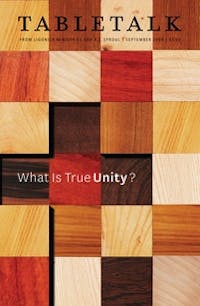
Request your free, three-month trial to Tabletalk magazine. You’ll receive the print issue monthly and gain immediate digital access to decades of archives. This trial is risk-free. No credit card required.
Try Tabletalk NowAlready receive Tabletalk magazine every month?
Verify your email address to gain unlimited access.
The relationship between the Mosaic covenant and the new covenant remains one of the most controversial and difficult topics in theology. As the notable American theologian Jonathan Edwards said, “There is perhaps no part of divinity attended with so much intricacy, and wherein orthodox divines do so much differ as stating the precise agreement and difference between the two dispensations of Moses and Christ.” There are those who so emphasize either discontinuity or continuity that the problem is solved by oversimplifying it. Most Christians, however, recognize that there are elements of continuity as well as discontinuity. The difficulty arises when we attempt to be more exact.
One of the most helpful books for those who are wrestling with the issues involved is Vern Poythress’ The Shadow of Christ in the Law of Moses (P&R, 1991). Dr. Poythress is professor of New Testament Interpretation at Westminster Theological Seminary in Philadelphia, Pennsylvania, where he has taught since 1976. In The Shadow of Christ, Dr. Poythress looks at the relationship between the Old and New Testaments, explaining how the Mosaic law looks forward to Jesus Christ and how it is fulfilled by Him in His person and work.
The Shadow of Christ in the Law of Moses is divided into two major parts. Part one is titled “Understanding the Different Aspects of the Law,” and Part Two is titled “Understanding Specific Penalties of the Law.” After a brief introductory chapter on interpreting the Old Testament, the remaining chapters of part one deal with specific issues such as the tabernacle, the sacrifices, the priesthood, the land, and the Law, explaining how each prefigures Jesus Christ. The tabernacle, for example, was where God Himself dwelled with Israel (Ex. 25:8). In various ways it prefigured Christ’s coming to dwell with His people (John 1:14).
The Old Testament sacrifices, of course, foreshadowed Christ’s once-for-all sacrifice on the cross (Heb. 10:1–18), while the Old Testament priesthood prefigured Christ’s work as our one, true High Priest (Heb. 8). The land is a significant aspect of the Mosaic law, so understanding its place in the new covenant is crucial. Poythress explains that the land has symbolic connections in several directions. It is not only a shadow of the new earth, it is a paradigm for the entire present earth. Regarding the instructions of God found in the Law, Poythress spends a good amount of time explaining the difficulties of properly interpreting them and offers his own solutions to several typical examples.
Part two deals at length with various judicial penalties and punishments found in the Mosaic law. Some may find such a discussion off-putting, but the issues are relevant as modern states deal with crime and punishment in their own contexts. Does the Old Testament offer guidelines for modern states? Such questions rose to the level of controversy in American Reformed circles in the 1970s and 1980s with the rise of the Reconstructionist movement and theonomy. Poythress faces the relevant issues directly in the chapters of part two.
In these chapters Poythress addresses the nature of just penalties for crimes. He specifically deals with questions of justice in relation to crimes involving theft, sexual issues, and the taking of human life. He addresses questions concerning deterrence and rehabilitation and offers a persuasive critique of prisons as a just means of punishment in most criminal cases. In the final chapter of part two, Poythress offers a very helpful explanation of what Matthew teaches regarding the fulfillment of the Law by Christ (Matt. 5:17–20). The book concludes with three appendices. The first addresses the question whether the state should punish false worship. The second is a lengthy critique of theonomy, in particular the version espoused by Greg Bahnsen. The final appendix addresses the meaning of the Greek word translated “fulfill” in Matthew 5.
It is unlikely that any reader will agree with every detail of Poythress’ exegesis or every detail of his explanation of the Mosaic law. Those who emphasize continuity and those who emphasize discontinuity will both disagree at some point, as will most of those who fall somewhere in-between. Every reader, however, will be forced to think about the law of God and how it relates to the Christian believer. Every believer will be forced to meditate on the Law and think about how it reveals Christ. There are few books that will assist readers with these important issues as much as this one will. I encourage all who love Scripture to read it and learn from it.
